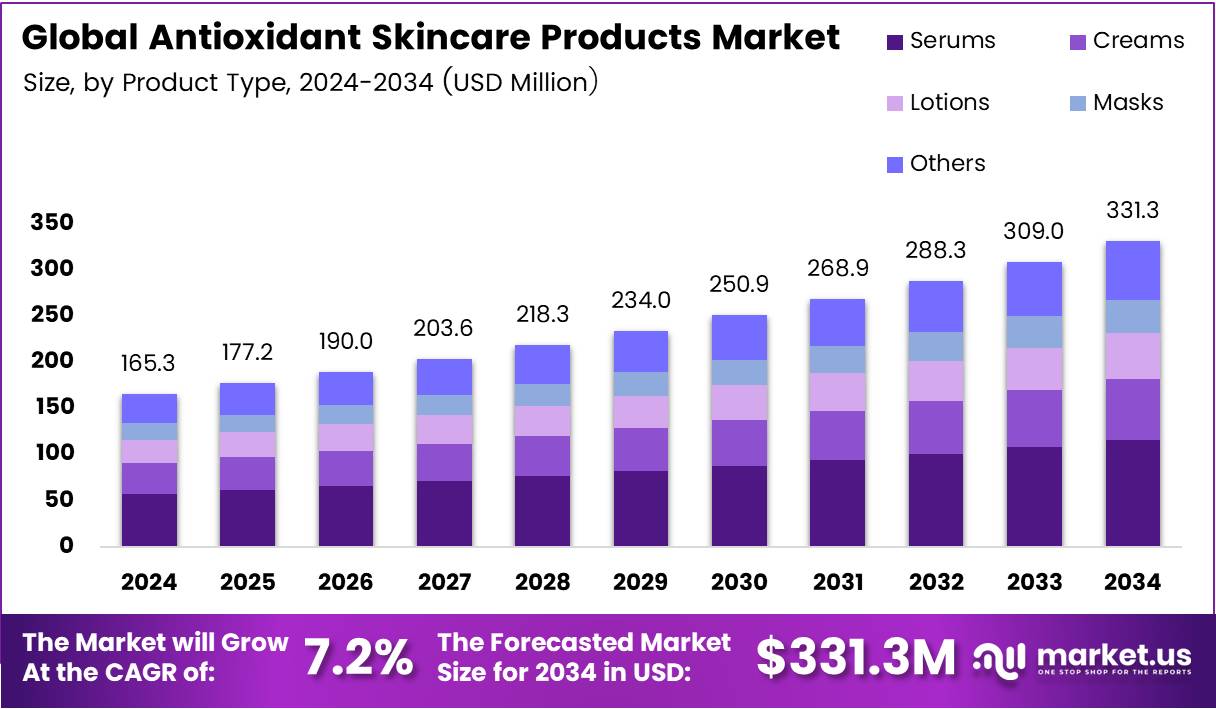Table of Contents
Introduction
The Global Antioxidant Skincare Products Market is projected to expand significantly, reaching USD 331.3 Million by 2034 from USD 165.3 Million in 2024. This growth trend highlights rising consumer concerns regarding skin damage caused by pollution, UV exposure, and aging. As customers prioritize preventive skincare, antioxidant-based formulations continue to gain strong traction.
Additionally, brands are developing advanced skincare products enriched with vitamin C, vitamin E, green tea extracts, and other natural sources of antioxidants. Meanwhile, e-commerce growth, sustainability emphasis, and product transparency are accelerating product accessibility and brand trust. As a result, the antioxidant skincare sector is evolving across mass-market and premium categories.

Key Takeaways
- The Global Antioxidant Skincare Products Market is projected to reach USD 331.3 Million by 2034, up from USD 165.3 Million in 2024, growing at a CAGR of 7.2%.
- Serums dominate the market by product type, holding a 34.9% share.
- Dry Skin segment leads by skin type with a 33.2% share.
- Female consumers represent the largest gender segment with 73.6% share.
- Anti-Aging is the leading application with a 39.3% share.
- Hypermarkets/Supermarkets dominate distribution channels with a 31.4% share.
- North America holds the largest regional market share of 43.7%, valued at USD 72.2 Million.
Market Segmentation Overview
By product type, serums remain the leading choice due to their high concentration of active antioxidants and fast absorption characteristics. Creams and lotions also continue to serve daily hydration and protection needs, while masks and other formulations expand product diversity through targeted skincare routines.
By skin type, the dry skin segment dominates the market as consumers seek formulations containing hydrating antioxidants that repair moisture barriers. Oily, combination, sensitive, and normal skin categories see rising product availability, offering customized solutions tailored to varying skincare needs.
By gender, female consumers account for a majority share due to higher skincare awareness, regular routine adoption, and broader product experimentation. However, male consumers are increasingly adopting antioxidant-based products as grooming habits evolve and awareness of pollution-related skin stress rises.
By application, anti-aging remains the top-performing segment as antioxidants help reduce wrinkles and fine lines. UV protection, skin brightening, and hydration solutions are also gaining traction as holistic skincare practices become mainstream across global markets.
By distribution channel, hypermarkets and supermarkets offer wide access to diverse product types, encouraging impulse and convenience-driven purchases. Specialty stores, pharmacies, salons, and online platforms continue to strengthen brand experience through expert guidance and personalization.
Take advantage of our unbeatable offer - buy now!

Drivers
Rising Preference for Natural Skincare: Consumers increasingly favor clean beauty products free from harsh chemicals. Antioxidants derived from plant-based sources such as berries, algae, and green tea are perceived as safer, boosting demand across premium and mass-market product ranges.
Growing Awareness of Pollution and UV Damage: Urban lifestyles contribute to rising exposure to environmental stressors that accelerate skin aging. Antioxidant skincare products offer defense against oxidative stress, making them highly desirable among health-conscious consumers.
Use Cases
Anti-Aging Skincare: Antioxidants neutralize free radicals responsible for premature aging. They are widely used in serums and creams formulated to reduce wrinkles, increase skin elasticity, and enhance natural radiance, all without invasive treatments.
Daily Protection and Maintenance: Antioxidant formulations serve as everyday defense mechanisms to restore skin vitality. Products such as moisturizers and tinted creams help maintain even complexion and provide essential nourishment for long-term skin health.
Major Challenges
Regulatory Complexity: Global regulations regarding cosmetic safety, labeling, and ingredient sourcing are strict. Companies must comply with different standards across regions, increasing costs and slowing new product introductions.
Market Flooded with Counterfeit Products: Low-quality or fake antioxidant skincare items create customer distrust. Poor-quality imitations may cause irritation, pushing consumers to avoid unfamiliar brands and slowing market expansion.
Business Opportunities
Expansion into Personalized and AI-Based Skincare: Companies can leverage data analytics to create products tailored to individual skin profiles. Personalized antioxidant skincare systems enhance product effectiveness and improve customer loyalty.
Growth of Men’s Grooming Segment: As men increasingly adopt anti-aging and pollution protection routines, brands can introduce masculine-themed antioxidant lines to capture an expanding consumer base.
Regional Analysis
North America: The region leads the global market due to high disposable incomes, greater consumer awareness, and the presence of advanced skincare brands. Strong demand for premium and clinical-grade formulations drives ongoing market expansion.
Asia Pacific: The region is witnessing rapid growth driven by rising beauty consciousness, digital influence, and expanding middle-class populations. South Korea, China, and Japan remain major innovation hubs for multifunctional antioxidant products.
Recent Developments
- In Mar 2025, Luxury Brands LLC and Dodo Group acquired BIA Skin to strengthen their premium skincare portfolio.
- In Jun 2025, L’Oréal Group announced plans to acquire a majority stake in Medik8 to expand in the high-performance skincare segment.
- In Dec 2024, L’Oréal Groupe completed the acquisition of Dr.G to reinforce its presence in the Asian skincare market.
Conclusion
The Global Antioxidant Skincare Products Market continues to grow as consumers adopt preventive and holistic skincare approaches. Rising awareness of environmental impacts on skin health, combined with innovation in natural and scientifically backed formulations, will support market expansion. Brands focusing on product transparency, personalization, and sustainable packaging are poised to achieve long-term competitive advantage.
Discuss Your Needs With Our Analyst
Please share your requirements with more details so our analyst can check if they can solve your problem(s)





